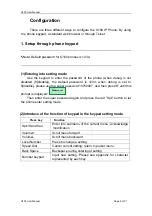
G100 User Manual
G100 User Manual
Page 21 of 31
(3) NAT settings
●
NAT:
If the G100 IP Phone is part of a network that uses address translation
(this is the case for every modern router) and if it needs to communicate with
another IP phone which is part of a different LAN (e.g. another IP phone that is
connected to the internet, please select an item from dropdown list to set the
proxy used by the phone. “Auto” is the best setting for the SIP protocol.
auto:
Select this option if logon server and IP phone are in the same LAN, or
the logon system supports IP phones working within a LAN (typical for routers).
enable:
When the system does not support IP phones working behind LAN,
please select this item to search public IP address of the NAT device. With this
item selected, the “NAT Address”
field will be used. Besides, port mapping (port
forwarding) needs to be properly set up on the NAT device.
Citron:
If the Citron private protocol is used, select this item to fit into the
GnuGK system for transfer of voice and signal data through the router.
auvtech:
Select this item if Auvtech private system is used.
STUN:
Select this item if the SIP protocol used and STUN is required. Please
enter the URI of a valid STUN server into the “NAT Address”
field.
Vida:
Select this item if Vida private system is used.
Aivgr:
Select this item if aivgr private system is used.
●
NAT Address:
If “Nat traversal” is set to “enable”, please enter the domain
name of your NAT server (such web servers help to determine the public IP
address of the G100 IP phone) into “nat addr”, such as
www.whatismyip.com
.
If
“Nat traversal” is set to “STUN”, please enter the URI of the STUN server for
your service provider into “NAT Address”, in the format “domain name: service
port or IP address:service port”. The default service port for stun is 3478.
●
NAT ttl:
If the IP phone is behind a NAT device, it will send packets to the
server every “
NAT ttl
” seconds to keep the port mapping on the NAT device alive.

























